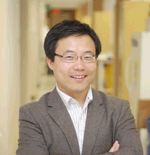2015 Young Investigator finalist: Weian Zhao

Nominee:
Nominated By:
Supporting Comments:
What made you choose a career in bioanalysis?
It was initially a shock when I realize doctors often treat patients before or even without a proper diagnosis. I have previously been frustrated when I have visited a doctor only to be told ‘try this drug first see if it works; if not, come back and I will give you something else’. Since these occurrences, I have decided to devote my career to developing simple and rapid biosensors and diagnostics that allow the physicians to first appropriately diagnose a disease so they can treat it effectively.
Describe the main highlights of your bioanalytical research, and its importance to the bioanalytical community.
Throughout my career I have focused on the development of bioanalytical tools that allow us to better address unmet biomedical questions, especially those that can be quickly translated to the market to help people. During my PhD studies I invented a simple-to-use paper based strip test using DNA aptamer sensors, which was awarded a Natural Sciences and Engineering Research Council (NSERC) Innovation Challenge Award. This technology is now being commercialized in a startup company in Canada for the detection of food pathogens. In one of my postdoctoral studies I developed a novel approach to use naturally homing stem cells to deliver fluorescent sensors to cell microenvironments in vivo, which represented a new paradigm in the study of cell signaling and communication in native niches. Most recently, in my own laboratory, we developed the Integrated Comprehensive Droplet Digital Detection (IC 3D), which introduces a new paradigm for rapid detection of low-abundance biomarkers directly from unprocessed complex biological samples. The IC 3D technology, which has been licensed to Velox Biosystems (CA, USA), a startup company that I founded recently, has great potential to address a long-standing unmet need of rapid detection of bloodstream infections and antibiotic resistance, which represents one of the greatest threats to humankind.
Describe the most difficult challenge you have encountered in the laboratory and how you overcame it.
My PhD thesis aimed to develop a test that could specifically detect single bacteria from a large volume of complex media within 60 min. The most difficult challenge was a technical one: it was extremely challenging to meet all five key analytical parameters including sensitivity, specificity, assay time, throughput, and robustness all at once. These parameters are seemingly incompatible: for instance, if you want to achieve single-cell sensitivity you will need to enrich cells to a detectable level, which compromises assay time. My ‘aha’ moment to conceive the IC 3D technology that overcomes the challenge resulted from conversations with researchers from different fields, including engineering and physics. In the IC 3D assay unprocessed samples are mixed with the fluorescent biosensors within a microfluidic channel, which are rapidly encapsulated into billions of individual picoliter droplets. The sensors will fluoresce in the droplets that contain bacterium. The droplets can then be counted by a high throughput particle counter that can robustly detect single fluorescent droplets from mL volumes within several minutes. What I learned is that interdisciplinary and collaborative research is an effective strategy to address the biggest challenges and that the real solution to a big problem should be simple.
Where do you see your career in bioanalysis taking you?
My research in the next five years will be focused on 1) the development of rapid diagnostics as part of the precision medicine initiative, i.e., ‘first diagnose, then treat’. We will focus on the global issue of antimicrobial resistance that kills hundreds of thousands of patients every year due partly to the lack of rapid diagnostics. 2) the development of an implantable biosensor system that can illuminate cellular environments in vivo, allowing us to visualize what a cell ‘sees’ (biochemical signals) and ‘feels’ (biophysical cues) and how it ‘talks to’ neighboring cells (cell-cell communication), or to monitor administered drugs continuously so that they can be maintained within their therapeutic range. Our ongoing work focuses on generating an expansive toolbox of real-time sensors. Specifically, we are developing a new sensor-screening platform that can quickly identify aptamer sensors from a library of a trillion unique DNA sequences through a high-throughput, single-molecule detection technology. This technology has the potential to generate hundreds of different sensors within days, rather than one sensor in years, as current systems do.
How do you envisage the field of bioanalysis evolving in the future?
I have been fortunate enough to work in the area of bioanalysis that will continue to revolutionize biology and medicine. Take next generation sequencing for example, it has transformed the way we study biology and practice medicine. The outlook of the field of bioanalysis has never been so bright. We will see more companion diagnostics emerging in next few years that will not only facilitate new drug trials by identifying the right patient population, but also allow us to give the right drug to the right patient at the right time. These technologies also have the potential to significantly lower mortality rates, improve patient outcomes, and reduce the cost of healthcare associated with diseases through early detection. In addition, next-generation in vivo sensor systems will be developed to interrogate complex biology directly in vivo, especially simultaneous monitoring of multiple biological processes including those in the brain. These in vivo sensor technologies will also permit real-time monitoring of administrated drugs and direct visualization of how cells interact with drugs in the body. Hence these new sensor technologies will also have far-reaching implications for the development of new drugs and diagnostics once we understand how cells and drugs truly function in vivo.
Please list up to five of your publications in the field of bioanalysis:
1. Kang K-D, Ali MM, W Zhao et al. Rapid detection of single bacteria in unprocessed blood using the Integrated Comprehensive Droplet Digital Detection. Nat. Commun. 5, 5427 (2014). (Highlighted in: Murray C, Adeyiga O, Owsley K, Di Carlo D. Research highlights: microfluidic analysis of antimicrobial susceptibility. Lab Chip 15(5), 1226—1229 (2015).)
2. Zhao W, Cui CH, Bose S et al. A Bioinspired Multivalent DNA Network for Capture and Release of Cells. Proc. Natl. Acad. Sci. USA 109, 19626—31 (2012).
3. Zhao W, Schafer S, Choi J et al. Cell surface sensors for real-time probing of cellular environments. Nat. Nanotechnol. 6(8), 524—531 (2011). (Highlighted in: DeFrancesco L. Cells as probes. Nat. Biotechnol. 29(9), 786—848 (2011).)
4. Zhao W, Chiuman W, Lam JC, et al. DNA aptamer folding on gold nanoparticle: from colloid chemistry to biosensors. J. Am. Chem. Soc. 130, 3610—3618 (2008).
5. Zhao W, Brook MA, Li Y. Design of gold nanoparticle based colorimetric biosensing assays. ChembioChem. 9, 2363-71 (2008).
Please select one publication from above that best highlights your career to date in the field of bioanalysis and provide an explanation for your choice.
I choose publication #1 listed above, the Nature Communications paper published in my independent laboratory. The Integrated Comprehensive Droplet Digital Detection (IC 3D) technology will not only have the potential to address a major global challenge of bloodstream infections and antibiotic resistance, but also represents a platform for rapid and sensitive detection of any low-abundance (1-100 target/mL) biomarkers. It also exemplifies the power of interdisciplinary and collaborative research in addressing major biological questions and unmet medical challenges.




